Artificial Intelligence Powers Robust Packaging Design
Akin to a programmable, high-speed virtual focus group with unlimited learning potential, Vizit technology thinks, acts, and learns like consumers.
February 23, 2021
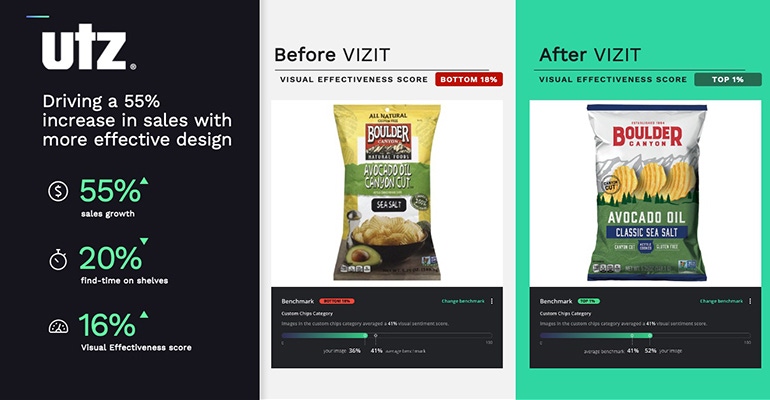
Artificial intelligence is exploding at a rate of 42% CAGR yearly in markets including healthcare, retail, finance, and manufacturing, but did you know it’s also used in packaging design?
Vizit, “the world's first Visual Intelligence company,” has launched what it calls a revolutionary Visual Brand Performance Platform that helps global consumer brands drive higher sales by optimizing their visual content and designs to power remarkable visual experiences for online consumers.
“Images are the most effective sales tool on the planet,” said Jehan Hamedi, CEO of Vizit. “To win in our saturated digital visual-centered world, companies need to optimize their visual brand performance and harness the power of their imagery to drive commerce with online consumers.”
Hamedi responds to Packaging Digest’s questions in this exclusive interview.
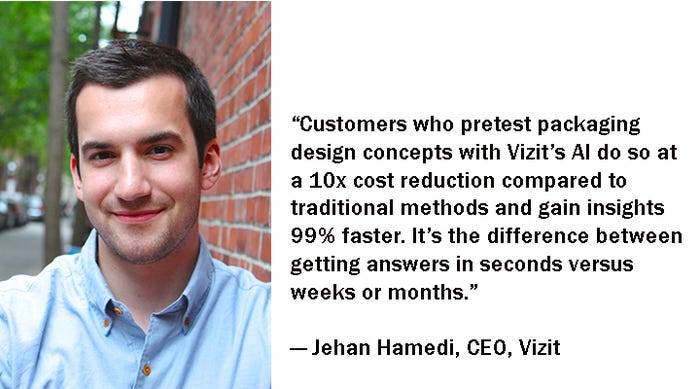
How does the tech work?
Hamedi: Vizit’s software works similarly to the human brain in how it evaluates the effectiveness of visuals. Vizit’s Artificial Intelligence (AI) decodes a visual asset (content, designs, photos, concepts, etc.) and breaks it into thousands of visual elements. It then analyzes them to determine how likely the visual is to generate interest with a specific audience by comparing those elements to thousands of other visuals the audience engaged with online. Essentially, Vizit helps our customers “see through the eyes” of the consumer audience segments they value most.
What specifically does AI bring to the equation?
Hamedi: Vizit’s revolutionary invention in AI is what we call an Audience Lens. An Audience Lens is a computer-generated consumer audience that leverages AI to simulate their preferences for a myriad of visual content. This is a technology that thinks, acts, and learns like your consumers. Think of a “virtual focus group” with unlimited learning potential.
Vizit customers leverage our Audience Lenses throughout the enterprise in marketing, ecommerce, insights, innovation, design, and brand functions to understand, inform, and optimize the success of new products, packaging, and related visual content. What’s most exciting is Vizit brings an entirely new source of consumer understanding to the Enterprise that’s algorithmic, real time, unbiased, and extremely cost efficient.
What’s involved?
Hamedi: Globally, Vizit learns from millions of images that consumers engage with online to power its patented Visual Intelligence technology which is used to instantly determine the effectiveness of visual content and design for any audience.
An audience is a unique group of consumers that have similar demographics characteristics, needs, wants, or purchase tendencies, that are relevant to a consumer brand. For each target audience, Vizit’s software analyzes new content and designs for over 15,000 visual cues — including subject matter, background, composition, colors, styling, and other important elements.
Then, Vizit uses this data to predict and score how effective your design will be, by comparing these elements to online engagement patterns we’ve observed from the audience segment you select.
A key component of Vizit’s cloud-based software platform is a visual intelligence database that centralizes data and insights into your target audience’s visual preferences and makes this information easily accessible across the enterprise. Vizit builds custom Lenses for our enterprise customers based on the profiles of their core consumers and target audiences.
The only thing required is a Vizit account and an Internet connection.
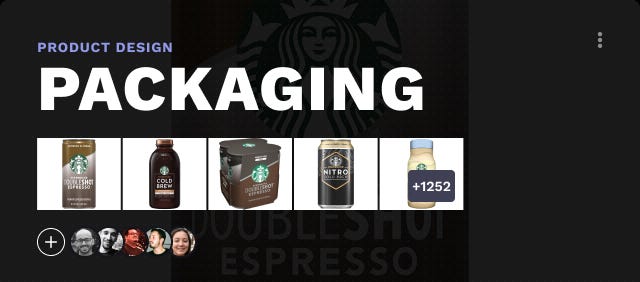
What’s the cost for a study/analysis — and what’s a typical ROI?
Hamedi: Each of our customers have unique visual branding challenges and our technology is deployed flexibly to aid in new product development, new campaigns, and other vital areas.
Most of the time we see that Vizit’s customers achieve a strong return-on-investment with just a single project or initiative and then this leads to other applications of the technology. Because Vizit’s platform is cloud-based, brands and packaging designers can glean instant, predictive insights into consumer preference in near-real-time, anywhere in the world, which rapidly accelerates learning, reduces cycle time and cost, and improves performance.
For example, enterprise customers who pretest packaging design concepts with Vizit’s AI do so at a 10x cost reduction compared to traditional methods and gain insights 99% faster. It’s the difference between getting answers in seconds versus weeks or months.
From a performance perspective, after one large snack brand leveraged Vizit to design and select a new collection of ecommerce-optimized packaging shots for their mobile hero images, they achieved a double digit increase in conversion rates on Amazon. It’s really difficult to quickly achieve such a large performance increase using any other technique.
Can you point to an example?
Hamedi: One of Vizit’s biggest success stories in new product design was achieved with Harley Davidson. Although motorcycles don’t have “packaging” in the traditional sense like consumer-packaged goods products, their bike is the packaging and similar to a CPG product, the bike’s visual design needs to create strong stopping power and evoke positive connections with consumers to influence their purchase behavior.
In the words of Luke Mansfield, the former vice president of beverage innovation at PepsiCo and current chief strategy officer and head of new product development for Harley Davidson, “Vizit saved us $5 million and two years of development predicting what customers would think about a new product. If you want to view your world through the eyes of your customer there’s simply no better way.”
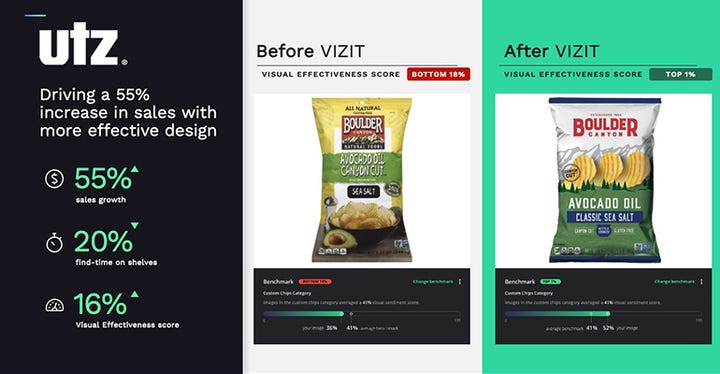
Let’s look at a packaging example: What can you say about Boulder Canyon snacks?
Hamedi: Vizit partnered with the very talented creative team at Interact Boulder who led the redesign of Boulder Canyon’s packaging for Utz Chips. The IB team leveraged our technology early in the development process as part of a unique AI-powered “test and learn” process, which helped them analyze and screen out a large set of packaging design options for effectiveness with Boulder Canyon’s target consumer audience.
One of the key questions Vizit helped answer was related to the visual presentation of avocado oil and the selection of background mountain graphics on the pack. For instance, with avocado oil as a key ingredient, how do you call attention to this element from a design perspective and ensure consumers will notice them and respond positively?
This is a perfect use-case for Vizit because our methodology deconstructs the design into thousands of visual elements, which can then be compared against alternate designs and compositions with even subtle variation. Vizit’s AI software does this in near real time to spotlight the design variations that have the strongest predicted impact with consumers, enabling a streamlined, data-informed decision-making process.
What was also unique about this initiative was the breadth of Audience Lenses deployed. Visual Intelligence made it possible for Boulder Canyon to learn from the visual preferences of potential consumers all across the country ranging from health food consumers, outdoor enthusiasts, male and female demographic segments, from the west coast to New England. All of these Lenses gave the team previously undiscoverable insights that the team used to help surface the hardest-working packaging design that was ultimately selected and has since led to a 55% increase in year-over-year sales and a 20% reduction in find-time on shelf. In the hands of designers, Vizit’s Visual Intelligence technology is a powerful enhancement, accelerant, and source of consumer insight to inform the creative development process.
How does this compare with conventional design methods?
Hamedi: Vizit’s methodology is unique. Our system learns from millions of unsolicited interactions with digital content to learn about the visual preferences of a particular consumer audience. Using this data, our technology is able to decode a complex set of subconscious “visual cues” that motivate consumers to act — without ever asking them any questions.
In addition, Vizit’s software provides attention mapping and other advanced heat mapping capabilities generate insights to optimize the design of new packaging in seconds.
Is this analysis and information applicable for physical and or virtual (online) packaging?
Hamedi: Any visual experience can be measured and optimized with Vizit. Our customers leverage Vizit’s visual intelligence to inform the design of physical packaging, ecommerce content, photography, printed materials — even the paint colors of motorcycles that are exported from CAD.
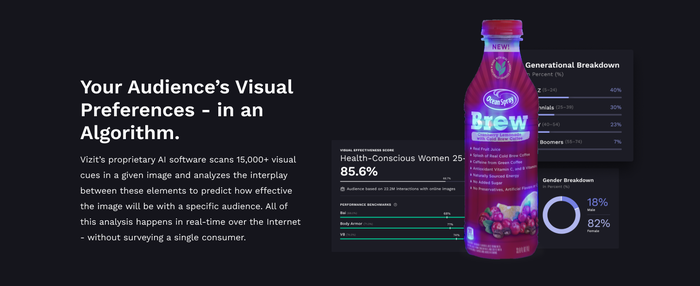
How can brands and packaging designers use this information?
Hamedi: Brands and packaging designers use Vizit throughout each stage of the creative process: ideation, concept iteration, selection and optimization.
For example, some of our customers use Vizit very early in concept development to gain a real-time read on design effectiveness. For these customers, Vizit’s Visual Brand Performance Platform allows customers to “double click” into the visual strategies that are most resonant with their consumer targets and to find and surface emerging visual trends.
Picture this: you are designing new packaging for a popular premium water brand. Your team creates 20 potential visual concepts. Which ones do you explore further? Are there two or three that are likely to create the most stopping power relative to a competitive set? How do you know?
Now what about your Target Audience? What design will generate the most interest with millennial women who make $100,000 and are healthy eaters? What about Walmart shoppers? How will you create a research study?
Using traditional approaches to research and innovation it would cost tens of thousands of dollars to answer each of those questions and take weeks or months to answer and often lead to inaccurate or incomplete results. Vizit removes this guesswork from design effectiveness and delivers visual intelligence while you are developing any new product concept, packaging concept, or creative design.
Some customers, through Vizit’s insights, have discovered entirely new creative lanes to explore that they would not have previously considered because of pre-existing brand guardrails.
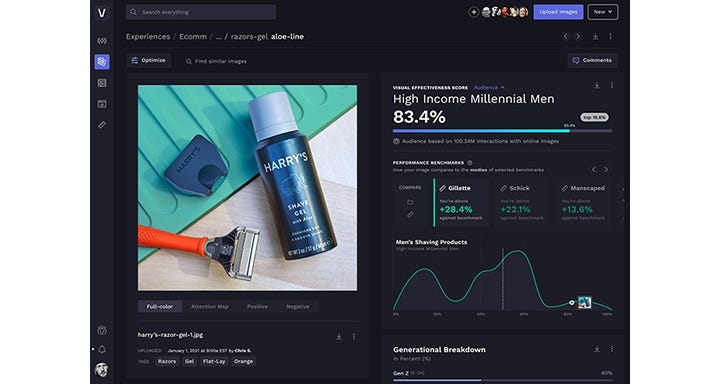
What other brands can you identify as clients?
Hamedi: We’re very fortunate to have partnered with some very forward-thinking brands in our early journey such as CLIF Bar and Ocean Spray, among many other household brands, including some of the largest global players in soda, snacks, coffee, and packaged meat that we cannot disclose by name.
What’s a takeaway packaging professionals should know about this tech?
Hamedi: These days packaging is ecommerce and ecommerce is packaging. As a result, every new packaging design you create needs a new set of data and intelligence to ensure it is optimized for online consumers as well as in-store consumers. In the digital, visually centered world, the visual design of your packaging is the single greatest asset to drive both higher online and in-person sales. In that way, packaging has become the gateway to consideration and your most powerful visual asset to drive sales with online consumers.
What if you had the power to instantly know whether your new visual branding will be a success with your target consumers? For Packaging and Innovation teams, Vizit’s software unlocks the power of design to reveal insights often overlooked or scoped out of a design brief because traditional research is too costly to apply across every idea and visual exploration. Vizit helps you get to the best ideas, faster and more efficiently than ever before, and ensures your new creation will have a visual advantage on the digital shelf. Simply put, Vizit is helping our customers see what sells.
You can watch a video of the Vizit technology.
You May Also Like


